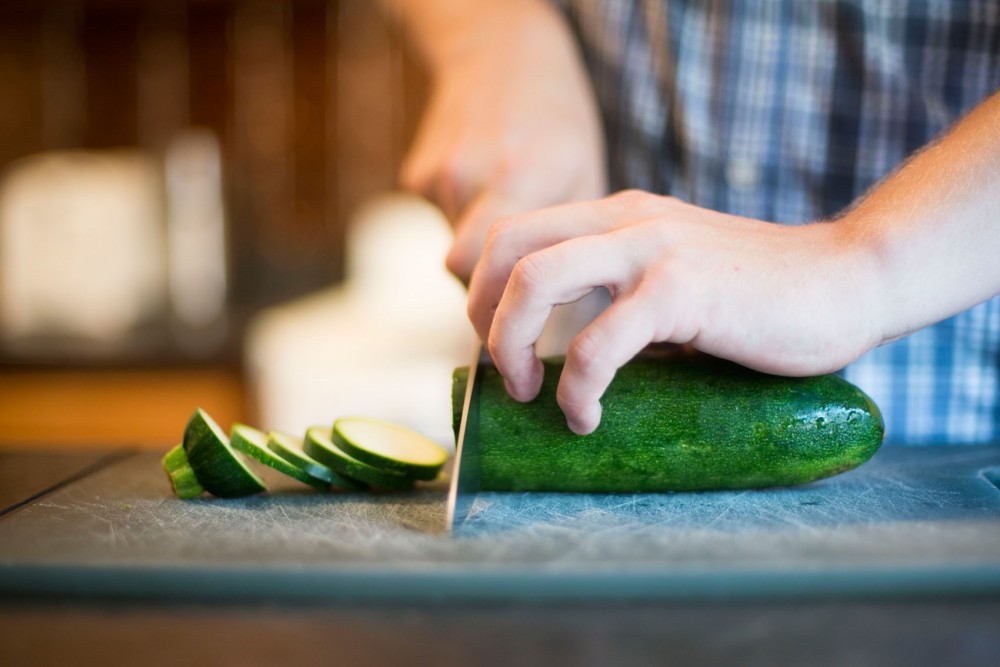So you’ve got your kitchen in order and you’re raring to go. Before you go all Edward Scissorhands on a bell pepper, keep in mind some basic guidelines for proper knife technique. If you want to win the hearts of millions with your cutting prowess, you’ll need to practice your skills. Otherwise, you’ll end up slicing your thumb and looking like a doofus.
No dish tests your chopping ability quite like ratatouille. Aside from being a completely unrealistic film that inaccurately represents the cooking process, it’s a cheap and straightforward dish that will help you develop your kitchen technique. A classic French vegetable stew, it works perfectly as a side dish or a main course — just serve over spaghetti or rice.
Knife Technique
First step to culinary competence: holding the knife without looking like the killer from “Psycho.” Choke up on the handle and grasp the blade between your thumb and forefinger. This way you can let the weight of the knife do most of the work while retaining complete control over the blade.
Although different vegetables take different techniques to cut, you typically will keep the tip of the knife on your cutting board and slice downward and away from yourself. This helps you control the movement of the knife and slice more economically.
Generally speaking, the fingers on your non-knife wielding hand should be curved in toward your palm. Never lay your fingers flat and expose them to the blade. After all, nicking your knuckle is better than chopping off a fingertip. Use your knuckles to guide the knife.
Ratatouille
Ingredients:
Olive oil
1/2 medium onion
3 cloves of garlic
1 eggplant
1 zucchini
1 green bell pepper
1 red bell pepper
2 medium tomatoes OR 1 14-ounce can of diced tomatoes
Dried parsley
Salt and pepper
Parmesan (optional)
Now, there are no essential veggies to put into ratatouille. It’s a perfect dish for clearing out any errant vegetables from your fridge — any kind of squash, for instance, is welcome.
Chop the eggplant, zucchini, onions and bell peppers into roughly half-inch chunks. Making them evenly sized will ensure that they all cook at equal speeds.
Mince the garlic or, if you’re lazy, buy it in jars, pre-minced.
Sauté the onions and garlic over high heat until they turn slightly translucent, sauté being a fancy French word for frying in oil. This should take about three minutes. Add the red and green bell peppers and cook for another 2 minutes. Throw in the eggplant and zucchini and fry for another 3-4 minutes, mixing often. All the while, make sure there’s enough oil in the pan to keep the mixture frying. If the bottom of the pan seems dry, add a touch more olive oil.
When all the veggies in your pan are nice and fried, add in the diced tomatoes and season the mixture with plenty of salt, pepper and a pinch of parsley. Mix thoroughly.
Bring the whole mixture to a boil, turn the heat to low and let simmer for 20 minutes. It should quickly take on a thick, stew-like consistency. If there isn’t enough liquid to simmer, add a splash of water.
While it’s simmering, periodically taste little bits of the dish and try to focus on what it lacks. Beginner chefs often underestimate the amount of salt to use, for instance. Salt brings out the best in a dish’s ingredients, helping enhance and highlight flavors.
After simmering, top the dish with grated parmesan and let melt before serving.
Simple dishes like ratatouille will help you build confidence in the kitchen while still providing a hearty meal. With enough practice, you’ll be a knife whiz in no time. And not in a Norman Bates kind of way.
Learn how to use a knife by watching our tutorial video here.
Watch








